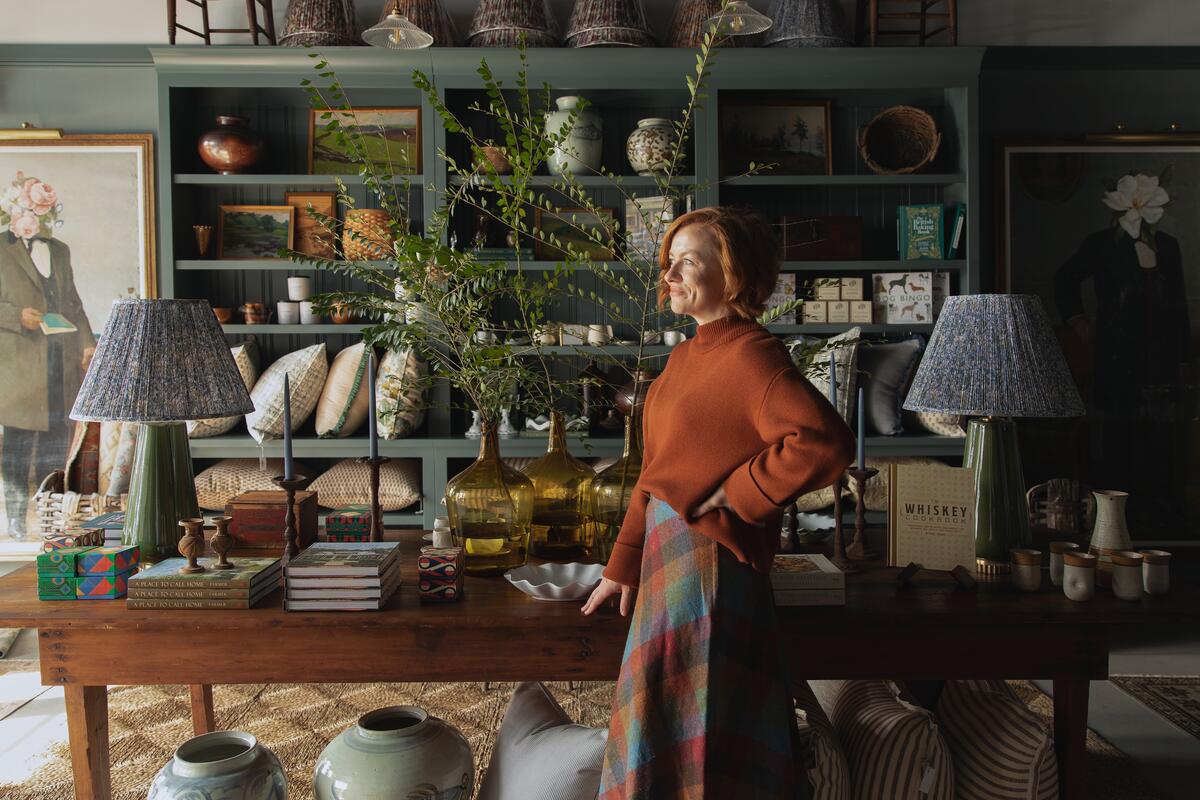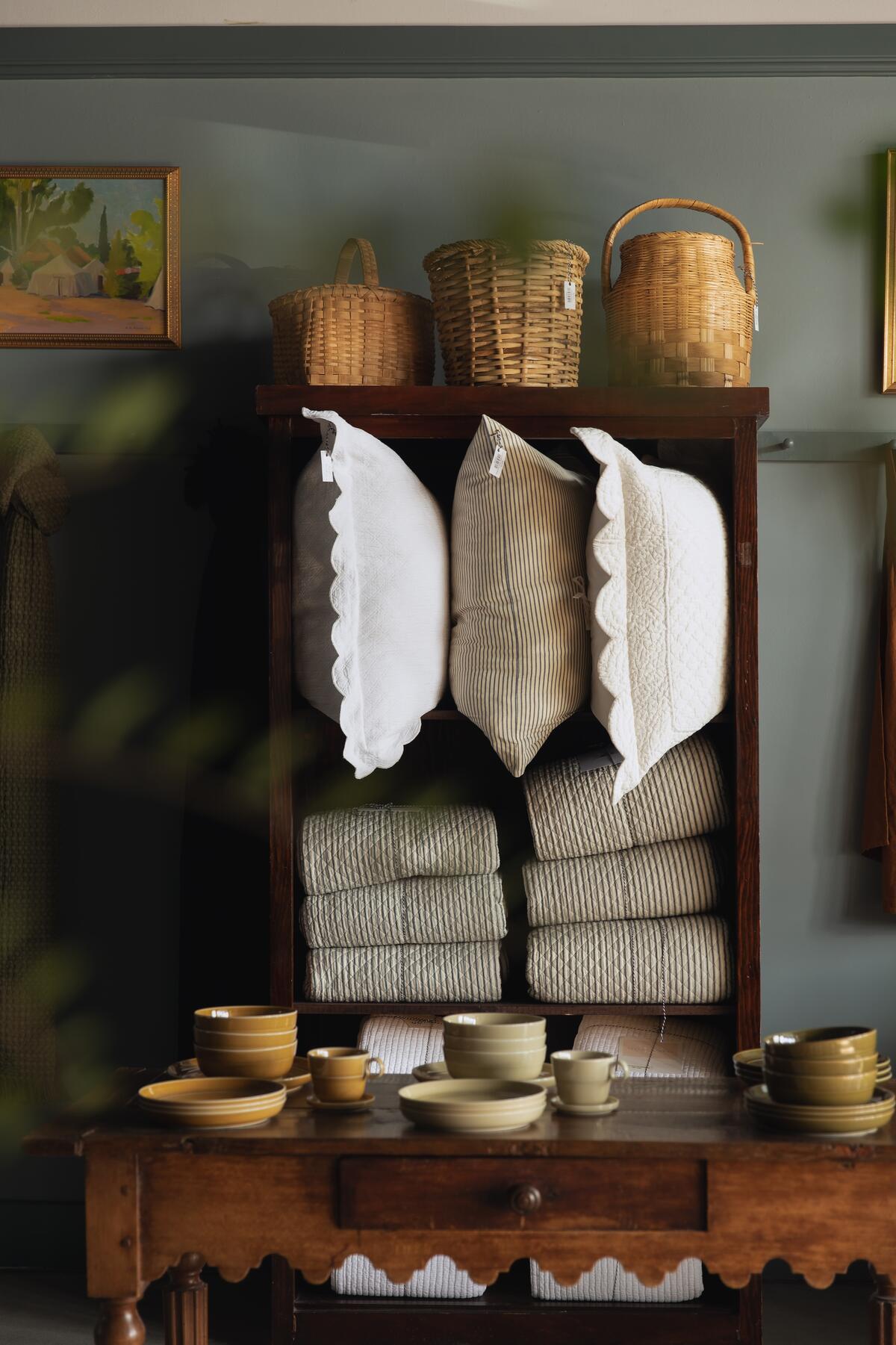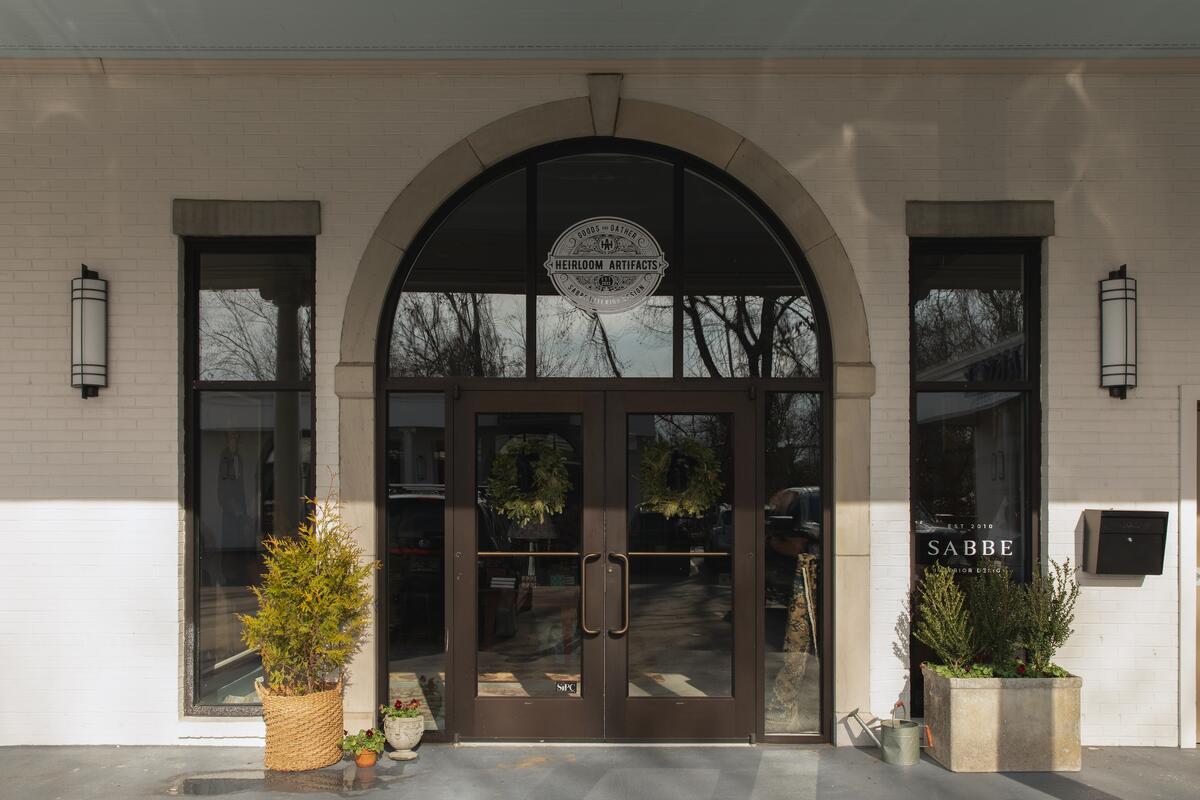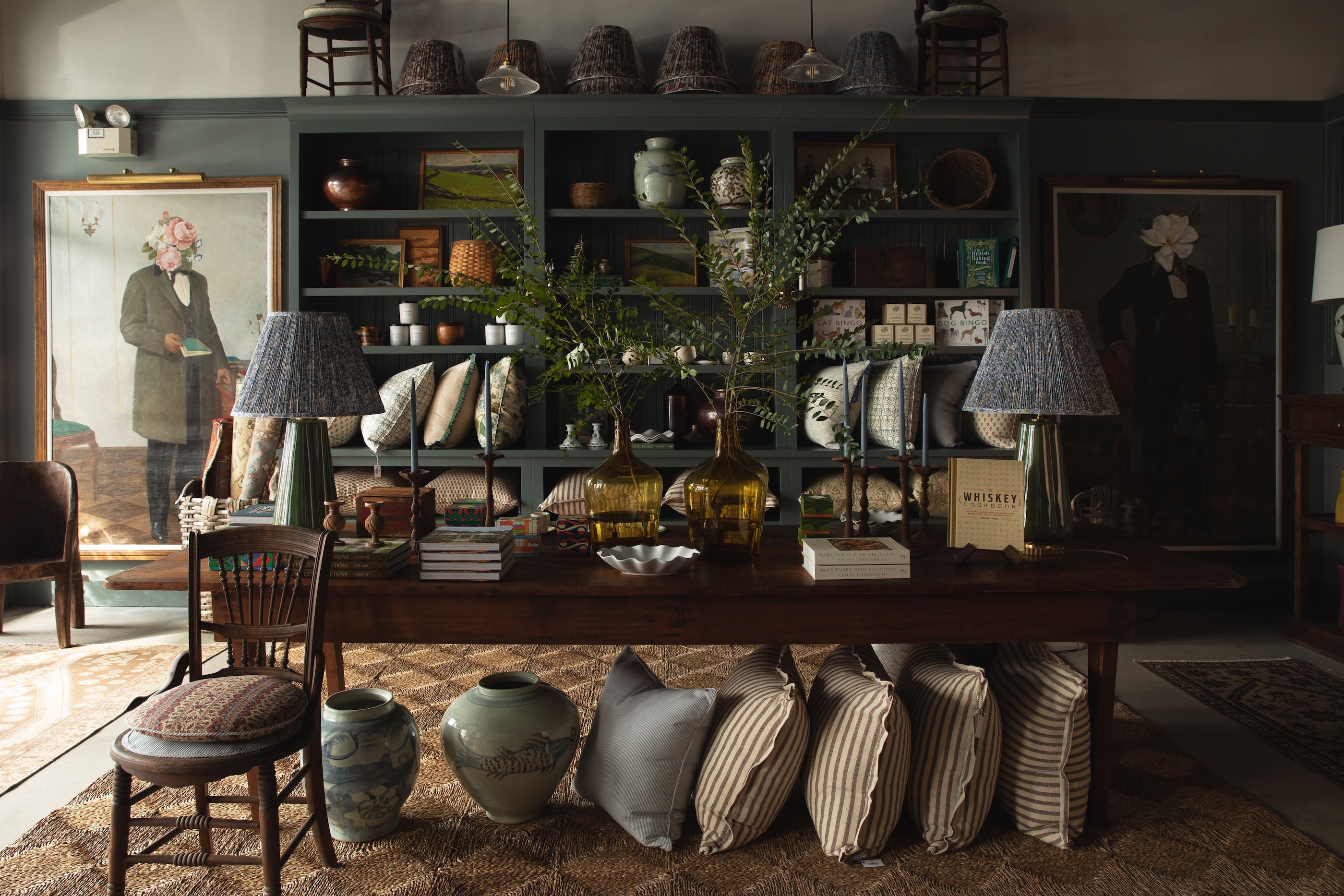In Business of Home’s series Shop Talk, we chat with owners of home furnishings stores across the country to hear about their hard-won lessons and challenges, big and small. This week, we spoke with Stephanie Sabbe, owner of Sabbe Interior Design and the Nashville shop Heirloom Artifacts.
Sabbe never thought she’d own a shop—and in fact, hated her first brush with retail in her college days. After design school, she worked in commercial architecture before launching her own firm in 2010; eventually, she was storing enough inventory in her studio space that she realized she could open a store. “I’m from a very blue-collar side of Nashville, and my friends couldn’t afford our services, for the most part,” she says. “[The store] gave me an opportunity to have this community space where friends could come in and be part of what we’re doing without having to sign on to spend $250,000 on furniture.”
The designer attributes her entrepreneurial mindset to a business development mentorship group she’s a part of, whose influence comes up again and again in her conversation with BOH. “The reason I named it Heirloom Artifacts is I would like to build it and sell it one day,” says Sabbe. Ahead, she discusses what success means to her, the endless power of word-of-mouth, and choosing an interior wall paint that complements her hair color.

Did you always have retail in the back of your mind as a possible career avenue?
No, never. I didn’t [even] want to own my own firm! I literally decided on a Tuesday, Oh, I’ll just open a shop, and within three months, I built out this space. I had all this antique furniture and was like, “I’ll just put it in here. It’s cheap storage.” We officially launched in December 2022, and in the summer of 2023 we went online. But no, I’ve never wanted to own a shop. I worked at Pottery Barn Kids in college and hated it.
Why did you hate it?
Oh, just standing at the front and greeting people. Or the kids that would come in and jump all over the duvets, and then I had to fluff them back up. I was 18 or 19, so everything was miserable.
What is the vibe of your store?
In 2021, my husband and I went to London for my 40th birthday. It was magical—and the retail shops were part of the experience for me. They were small and well-curated, [not these] American mega-stores with 52 options. There were places that sold 30 books and some china, and it was just so charming. My shop is similar, in that it’s dark and moody. We have Benjamin Moore’s Knoxville Gray on the walls. I had the pendant lights made locally with this fluted glass that gives it a very dim, romantic [aura]. I love this BBC show Call the Midwife; it feels like that to me in there. It’s not too shiny. We left the floors exposed concrete, and we have Turkish rugs. It’s just very vibey, even though it’s in a strip mall, which is the bane of my existence.
How does the store fit into the Nashville scene?
The city’s not very walkable in what is actually old Nashville. In a lot of the newer parts, they’ve put in sidewalks, but old Nashville was farming towns and plantations, so we don’t have interconnecting sidewalks. Our shop is between a ballroom dance place and a Pilates studio, in a very classic 1970s strip-mall-type setting, but it’s considered one of the better places to have a space in our area because there are just not a lot of options. People have to drive here, people have to fight to park here. I had the Plain English people come here to sell me cabinets, and I was like, “Oh God, don’t look.” It’s embarrassing.
Tell me more about the decision to paint it this deep teal color, the Knoxville Gray.
Green is my default, typically, so I first painted it a muddy green. I took a picture and sent it to a friend, and she was like, “Whoa, that is not good.” I let that sit when it was just a space for inventory, but once we launched into retail, I actually studied color palettes that felt good—I was going for this kind of bluesy, London, rainy-day retreat, and the two-tone blue felt right. I think I’ll keep it. I thought I would switch it out annually, but it seems like a lot of work.

I love the color. It’s one of my favorites.
It’s mine too. I have red hair, so it’s going to be blue [or] green.
Who is your typical customer? How much is foot traffic—well, car traffic—versus the trade?
I say my best customers are my design friends, because they’ll come and buy a lot. One [example]: Lindsay Rhodes is a local designer who works for a lot of famous people, and recently Kacey Musgraves posted this picture on her Instagram, and she had one of my lamps sitting on a table. I was like, “God, I love Nashville, where your girlfriend who you run carpool with is Kacey Musgraves’s designer.”
That’s awesome. What is the balance of merchandise?
I would say 25 percent is antiques. Most of the furniture is one-offs and found pieces. Then 25 percent is stuff I've manufactured, and the rest I’ve bought through wholesale sites.
Do you use any of the online platforms, or how are you finding that stuff?
We went to NY Now and Shoppe Object. We touch and feel and smell candles and all the things. We have accounts with all the book distributors. But Faire makes it so easy. I think it’s fun because you can see where other people are buying, and they honor territory, which is nice.
Is there a certain product that flies out the door?
My lamps. I created enough buzz so people know that’s the thing. Our initial order was 200 lamps, and I think we have 75 left. We used to sell these candle chasers, but then I had a dinner party and one fell off a wall at my house. I don’t want to push these as much anymore because Americans don’t like liability, and they are a liability.
Do you think the shop helps get design clients for you?
No. I don’t know if people in these interviews [usually] try to make themselves look shiny. I am always like, “Here’s the real dirt!” But I was in every magazine last year for this shop—Veranda, Garden & Gun, Business of Home, all of ’em—and did I get a major influx of calls for new work? No. We get our best clients in Nashville from just knowing people. And I hate that, because I went to freaking college [for design], you know what I mean? It feels very unjust that social connections are what drives good work.
What is your personal favorite category in the store?
Well, the lamps feel like my fifth child and were a big investment. If you want to tell a story of me in a nutshell, it’s that I found a manufacturer online from China and was like, “Hey, I drew a sketch. Can you make these lamps?” He made one, and then I wrote him a check for $20,000, [having] never met him. My husband was like, “What the frick?” It worked, but I totally could have lost all that money.
You’ve really got to be a risk-taker in this retail business!
I love interior design, but I’m addicted to the [NPR] podcast How I Built This. It’s just fun [listening to] these serial entrepreneurs. That’s what I get excited about. Interior design is a service. Yes, we sell goods, but I never want to feel like I’m pushing expensive goods on people to make more of a margin, because it just feels slimy. So it’s fun to think of other ways to build a company.
Are there other products you are interested in, or would you like to expand the lamps?
I’m going to develop a lampshade and have some new patterns made, because I feel like that’s a hole in the market. Bedding feels like a hole in the market—one that I don’t want to tackle, but I have ideas. We use Taylor Linens in the shop; it’s a company that you can buy retail online, but they sell to the trade, and I’ve talked to Lynne [Taylor] about partnering because it’s our go-to bedding. That’s what the shop is—a curation of a lot of our go-tos—because if the ship went down, I know I can sell it to clients.

How do you feel about e-commerce?
I love it. There is no more thrilling thing than being at dinner with friends and getting a ping on your phone that you sold something on Shopify. But we haven’t done well. We’ve done fine. We sold the majority of our lamps online for sure, but it’s not something I’ve promoted. I’ve never linked it to the shop’s Instagram, but that’s something I would like to explore further. We are much more of a brick-and-mortar.
How do you feel about the future of small businesses?
It’s a really interesting question, in that: What does it mean for a company to be successful? That business group that I was telling you about is majority white men, and their general model is to grow, grow, grow. I work four days a week. I have four children. I pick them up most days from school because I have a staff now. I don’t work late at night. [My design firm] takes what we can do and we don’t take any more. We get a ton of calls that we don’t take. And to a lot of the guys I’m in this group with, I am not allowing my company to grow.
The shop could be way bigger. It’s less than 500 square feet. We don’t carry a lot of big furniture. I’m selling paper straws. To me, the success of a company is to make what we need to pay my staff and cover our expenses and a little extra, but it’s not trying to build an empire. Same with other interior designers. There’s a ton in Nashville; I’m not threatened by that, because it only takes a couple of projects to be busy. You don’t have to have every client as your client. We don’t have to have every customer shop with us.
But you mentioned that you’d like to eventually sell the shop, so how do you square those two ideas?
I don’t know! I listen to a lot of podcasts on it. My ideal buyer doesn’t want an empire. It doesn’t have to be a “sell,” like I’m selling some huge dot-com. But the margins within interior design are shockingly high. My [accounting] books [for] the shop look great because I am selling the [products] through the [design] office, but I’ve only been doing it for a year and change, so we’ll see. I just love the idea of building and selling. I think we could kill it online if I got a little more sophisticated [at it] and plugged into TikTok and Instagram a little better.
What’s your favorite day as a shop owner?
Thursdays are [when] we have the workshops, and those are fun days because we are cleaning and prepping and styling, and people are in and out: “What are you doing?” The doors are open, and the neighbors come over. Thursdays are always a beehive of people.
I’m a people person. I love to get to know people. I can do the talking part of the shop, but I cannot check people out. I let somebody leave one time with $450 of stuff, like, “Your card’s not working, but it’ll work. Just go!” I believe she called back. I don’t know, I’ve always wanted to live in a small town where everyone goes to bingo night and [there’s] a real sense of that community.




























